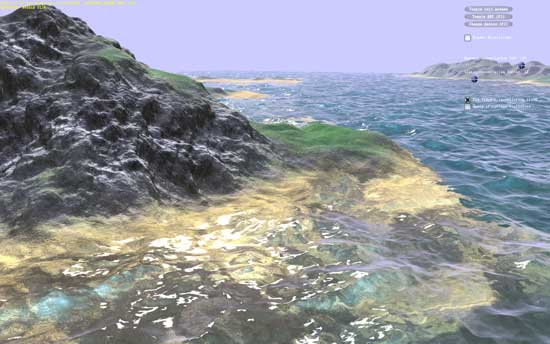Why NVIDIA Is Focused On Geometry
Up until now we haven’t talked a great deal about the performance of GF100, and to some extent we still can’t. We don’t know the final clock speeds of the shipping cards, so we don’t know exactly what the card will be like. But what we can talk about is why NVIDIA made the decisions they did: why they went for the parallel PolyMorph and Raster Engines.
The DX11 specification doesn’t leave NVIDIA with a ton of room to add new features. Without the capsbits, NVIDIA can’t put new features on their hardware and easily expose them, nor would they want to at risk of having those features (and hence die space) go unused. DX11 rigidly says what features a compliant video card should offer, and leaves you very little room to deviate.
So NVIDIA has taken a bit of a gamble. There’s no single wonder-feature in the hardware that immediately makes it stand out from AMD’s hardware – NVIDIA has post-rendering features such as 3D Vision or compute features such as PhysX, but when it comes to rendering they can only do what AMD does.
But the DX11 specification doesn’t say how quickly you have to do it.

Tessellation in action
To differentiate themselves from AMD, NVIDIA is taking the tessellator and driving it for all its worth. While AMD merely has a tessellator, NVIDIA is counting on the tessellator in their PolyMorph Engine to give them a noticeable graphical advantage over AMD.
To put things in perspective, between NV30 (GeForce FX 5800) and GT200 (GeForce GTX 280), the geometry performance of NVIDIA’s hardware only increases roughly 3x in performance. Meanwhile the shader performance of their cards increased by over 150x. Compared just to GT200, GF100 has 8x the geometry performance of GT200, and NVIDIA tells us this is something they have measured in their labs.
So why does NVIDIA want so much geometry performance? Because with tessellation, it allows them to take the same assets from the same games as AMD and generate something that will look better. With more geometry power, NVIDIA can use tessellation and displacement mapping to generate more complex characters, objects, and scenery than AMD can at the same level of performance. And this is why NVIDIA has 16 PolyMorph Engines and 4 Raster Engines, because they need a lot of hardware to generate and process that much geometry.
NVIDIA believes their strategy will work, and if geometry performance is as good as they say it is, then we can see why they feel this way. Game art is usually created at far higher levels of detail than what eventually ends up being shipped, and with tessellation there’s no reason why a tessellated and displacement mapped representation of that high quality art can’t come with the game. Developers can use tessellation to scale down to whatever the hardware can do, and in NVIDIA’s world they won’t have to scale it down very far to meet up with the GF100.
At this point tessellation is a message that’s much more for developers than it is consumers. As DX11 is required to take advantage of tessellation, only a few games exist while plenty more are on the way. NVIDIA needs to convince developers to ship their art with detailed enough displacement maps to match GF100’s capabilities, and while that isn’t too hard, it’s also not a walk in the park. To that extent they’re also extolling the other virtues of tessellation, such as the ability to do higher quality animations by only needing to animate the control points of a model, and letting tessellation take care of the rest. A lot of the success of the GF100 architecture is going to ride on how developers respond to this, so it’s going to be something worth keeping an eye on.

NVIDIA's water tessellation demo

NVIDIA's hair tessellation demo










115 Comments
View All Comments
chizow - Monday, January 18, 2010 - link
Looks like Nvidia G80'd the graphics market again by completely redesigning major parts of their rendering pipeline. Clearly not just a doubling of GT200, some of the changes are really geared toward the next-gen of DX11 and PhysX driven games.One thing I didn't see mentioned anywhere was HD sound capabilities similar to AMD's 5 series offerings. I'm guessing they didn't mention it, which makes me think its not going to be addressed.
mm2587 - Monday, January 18, 2010 - link
for nvidia to "g80" the market again they would need parts far faster then anything amd had to offer and to maintain that lead for several months. The story is in fact reversed. AMD has the significantly faster cards and has had them for months now. gf100 still isn't here and the fact that nvidia isn't signing the praises of its performance up and down the streets is a sign that they're acceptable at best. (acceptable meaning faster then a 5870, a chip that's significantly smaller and cheaper to make)chizow - Monday, January 18, 2010 - link
Nah, they just have to win the generation, which they will when Fermi launches. And when I mean "generation", I mean the 12-16 month cycles dictated by process node and microarchitecture. It was similar with G80, R580 had the crown for a few months until G80 obliterated it. Even more recently with the 4870X2 and GTX 295. AMD was first to market by a good 4 months but Nvidia still won the generation with GTX 295.FaaR - Monday, January 18, 2010 - link
Win schmin.The 295 ran extremely hot, was much MUCH more expensive to manufacture, and the performance advantage in games was negligible for the most part. No game is so demanding the 4870 X2 can't run it well.
The geforce 285 is at least twice as expensive as a radeon 4890, its closest competitor, so how you can say Nvidia "won" this round is beyond me.
But I suppose with fanboy glasses on you can see whatever you want to see. ;)
beck2448 - Monday, January 18, 2010 - link
Its amazing to watch ATI fanboys revise history.The 295 smoked the competition and ran cooler and quieter. Fermi will inflict another beatdown soon enough.
chizow - Monday, January 18, 2010 - link
Funny the 295 ran no hotter (and often cooler) with a lower TDP than the 4870X2 from virtually every review that tested temps and was faster as well. Also the GTX 285 didn't compete with the 4890, the 275 did in both price and performance.Its obvious Nvidia won the round as these points are historical facts based on mounds of evidence, I suppose with fanboy glasses on you can see whatever you want to see. ;)
Paladin1211 - Monday, January 18, 2010 - link
Hey kid, sometimes less is more. You dont need to post that much just to say "nVidia wins, and will win again". This round AMD has won with 2mil cards drying up the graphics market. You cant change this, neither could nVidia.Just come out and buy a Fermi, which is 15-20% faster than a HD 5870, for $500-$600. You only have to wait 3 months, and save some bucks until then. I have a HD 5850 here and I'm waiting for Tegra 2 based smartphone, not Fermi.
Calin - Tuesday, January 19, 2010 - link
Both Tegra 2 and Fermi are extraordinary products - if what NVidia says about them is true. Unfortunately, it doesn't seem like any of them is a perfect fit for the gaming desktop.Calin - Monday, January 18, 2010 - link
You don't win a generation with a very-high-end card - you win a generation with a mainstream card (as this is where most of the profits are). Also, low-end cards are very high-volume, but the profit from each unit is very small.You might win the bragging rights with the $600, top-of-the-line, two-in-one cards, but they don't really have a market share.
chizow - Monday, January 18, 2010 - link
But that's not how Nvidia's business model works for the very reasons you stated. They know their low-end cards are very high-volume and low margin/profit and will sell regardless.They also know people buying in these price brackets don't know about or don't care about features like DX11 and as the 5670 review showed, such features are most likely a waste on such low-end parts to begin with (a 9800GT beats it pretty much across the board).
The GPU market is broken up into 3 parts, High-end, performance and mainstream. GF100 will cover High-end and the top tier in performance with GT200 filling in the rest to compete with the lower-end 5850. Eventually the technology introduced in GF100 will diffuse down to lower-end parts in that mainstream segment, but until then, Nvidia will deliver the cutting edge tech to those who are most interested in it and willing to pay the premium for it. High-end and performance minded individuals.